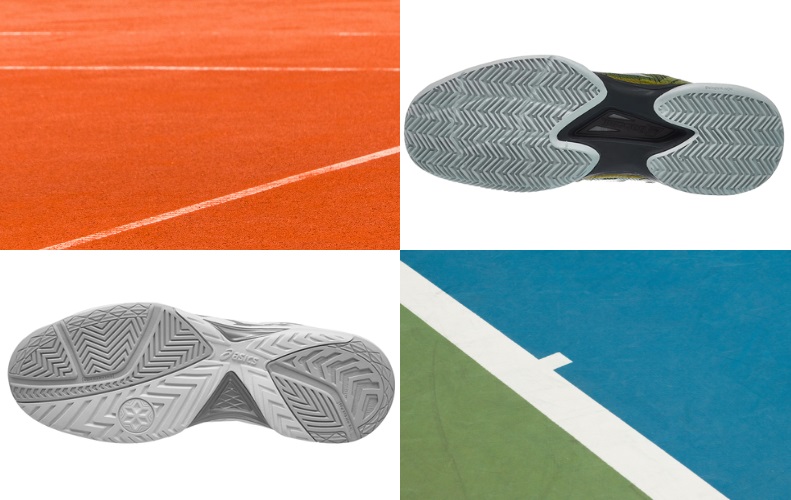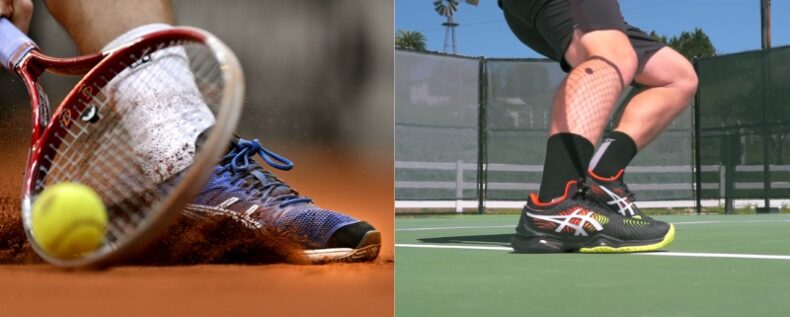If you have been wadded through the internet for the next pair of tennis shoes, then you must have come across about clay court shoes vs hard court shoes, and asked yourself, aren’t tennis shoes versatile?
Well, to your surprise, not all tennis shoes are the same, there are tennis shoes that are best suited for hard courts, and then there are tennis shoes that work best on clay courts.

The main difference between clay court shoes and hard court shoes is the midsole cushioning and outsole grip. If you are still confused about the difference between clay court shoes vs hard court shoes, then this guide is specifically for you.
That being said, let’s jump into the details.
Table of Contents
Difference Between Clay Court Shoes Vs Hard Court Shoes
Since playing tennis on hard courts is a completely different game compared to the clay courts. Therefore, the tennis shoes used on the hard courts need to be much more durable than the clay courts, which are quite lenient to the shoes.
However, the sole is not the only differentiating factor between these shoe types. Thus, below we have listed all the differences between clay court shoes and hardcourt shoes. Also, we have compiled an extensive guide.

1. Clay Court Tennis Shoes
Clay courts are the slowest type of courts among hardcourts and grass courts. Thus, the clay-court shoes are designed accordingly. Claycourt shoes do not need to be as rigid as hardcourt shoes. However, they need to provide more traction and control you need on a slippery surface.
Upper
The upper of the clay-court shoes are made out of synthetic textile or mesh. There is no major difference between the uppers of both the hard court and clay court shoes. Although, the clay court tennis shoes have a slightly lighter upper with more perforations than the hard court shoes.
Midsole
A majority of the clay-court shoes have EVA midsole with medium shock absorption capabilities. These shoes are flatter than their Harcourt counterparts, and there is not much shock absorption required on the clay courts due to the soft clay structure.
Sole
Sole is the most important aspect and the feature that is completely different between clay court tennis shoes and hardcourt tennis shoes.
The clay-court tennis shoes have a flat sole with a herringbone or a zigzag pattern. The grip on the sole of the claycourt tennis shoes is much more dense, which provides you the traction and control on a clay court.
Benefits of Clay Court Shoes
Enhanced Lateral Movement: Clay court shoes allow you to move quickly from side to side with ease, letting you reach those difficult shots effortlessly.
Reduced Slipping Risk: The shoes’ advanced traction ensures you stay stable, even on the slippery clay surface, minimizing the chances of painful falls.
Court Maintenance: Clay court shoes are designed to leave minimal marks on the court, preserving its integrity for a more extended period.
2. Hard Court Tennis Shoes
Hard courts are the mainstream tennis courts in the united states. These courts are immensely popular, and a majority of beginners start their tennis careers on these courts. Also, these courts are super rigid and face-paced. Thus they need tennis shoes that can withstand the hardships quite easily.
Upper
The Upper of the hardcourt tennis shoes is almost the same as the clay court tennis shoes with a minor change, and the hardcourt tennis shoes have an upper with perforations that offer breathability. Also, the upper has been treated in a way that can provide you with amazing durability.
Midsole
The midsole of the hardcourt tennis shoes is made out of EVA material that provides these shoes with excellent shock absorption capabilities.
Also, there is an ample amount of padding on the inner side of the shoes, which can provide cushioning during sudden jumps and maneuvering on the hard courts.
Sole
Although the sole of the hardcourt tennis shoes may look the same like the claycourt tennis shoes. However, they are not, as the pattern on the hardcourt tennis shoes has more graving, and they are less dense. The hardcourt tennis shoes have exceptionally reliable outer soles.
Benefits of Hard Court Shoes
Superior Grip: Hard court shoes offer exceptional traction, preventing any slipping and enabling quick direction changes on the unforgiving surface.
Impact Protection: With added cushioning and shock absorption, these shoes protect your joints and feet from the hard court’s relentless impact, reducing the risk of injuries.
Versatility: Hard court shoes are suitable for other court surfaces as well, making them a practical choice if you play on different courts regularly.
| Shoe Part | Hard Court Shoes | Clay Court Shoes |
| Upper | Breathable mesh or synthetic with excellent durability. | Breathable mesh or synthetic with medium durability. |
| Midsole | Excellent Shock Absorption with the usage of EVA midsole. | Medium shock absorption qualities to withstand medium shocks. |
| The Outsole | Sole of the Harcourt tennis shoes is less dense, and highly durable. | The sole of the claycourt tennis shoes is dense and flat. However, they are not as durable as hardcourt tennis shoes.. |
{ "@context": "http://schema.org", "@type": "VideoObject", "name": "Clay Court Shoes vs Hard Court shoe Tennis", "description": "Clay Court Shoes vs Hard Court shoe Tennis I talk about my experience adding clay court or har tru shoes to my game. What is the difference clay vs hard court shoes? Find out here.", "thumbnailUrl": "https://i.ytimg.com/vi/_Mzx8stDEqY/default.jpg", "uploadDate": "2019-01-21T20:23:45Z", "duration": "PT6M21S", "embedUrl": "https://www.youtube.com/embed/_Mzx8stDEqY", "interactionCount": "2729" }
Clay Court Shoes Vs Hard Court Shoes
- Sole Design – Clay court shoes have a herringbone pattern on the outsole that helps provide excellent traction and grip on clay surfaces, while hard court shoes have a more durable rubber sole designed to withstand the abrasive surface of hard courts.
- Cushioning – Hard court shoes generally offer more cushioning and shock absorption than clay court shoes due to the harder surface of hard courts, which can be tough on the feet and joints.
- Weight – Clay court shoes tend to be lighter and more flexible than hard court shoes, allowing for quick and agile movements on the clay surface. Hard court shoes are heavier and more stable, providing support for lateral movements on hard courts.
- Durability – Hard court shoes are typically more durable than clay court shoes due to the wear and tear of the harder surface. Clay court shoes can wear out quickly on hard courts, so they are not recommended for this surface.
- Surface-specific – It is important to choose the right shoe for the specific court surface you will be playing on. Using clay court shoes on a hard court surface can cause damage to the shoe and affect your performance, while hard court shoes may not provide enough traction on a clay surface, leading to slipping and sliding.
Comparison: When Choosing Between Clay Court Shoes and Hard Court Shoes, Consider The Following Factors:
Traction: Clay court shoes have specialized traction for sliding, while hard court shoes offer a strong grip.
Durability: Clay court shoes are less durable due to the nature of the surface, while hard court shoes are designed for longevity.
Support: Both types offer adequate support, but hard court shoes provide extra cushioning for impact protection.
Versatility: If you play on various surfaces, hard court shoes might be a more versatile option.
Factors to Consider
Playing Style: Assess your playing style to determine the shoe features that align with your needs, whether it’s agility on clay or stability on hard courts.
Comfort: Always choose shoes that feel comfortable and snug on your feet to enhance your performance and prevent discomfort.
Performance Impact: Proper shoes can significantly improve your game, so invest in a pair that complements your playing style.
Conclusion – Clay Court Shoes Vs Hard Court Shoes
Although Clay Court tennis shoes and hard court tennis shoes might look the same, however, there is a bunch of difference between the two, as they both are manufactured to be used for different purposes.
The clay-court tennis shoes have a breathable and well-ventilated upper, with medium shock absorption capabilities, and medium reliability.
On the other hand, hardcourt tennis shoes are versatile, have excellent padding, and offer superior traction and control.
{ "@context": "https://schema.org", "@type": "ItemList", "itemListElement": [ { "@type": "ListItem", "position": 1, "name": "Difference Between Clay Court Shoes Vs Hard Court Shoes", "url": "https://besttennisreviews.com/clay-court-shoes-vs-hard-court-shoes/#Difference_Between_Clay_Court_Shoes_Vs_Hard_Court_Shoes" }, { "@type": "ListItem", "position": 2, "name": "Clay Court Tennis Shoes – Clay Court Shoes Vs Hard Court Shoes", "url": "https://besttennisreviews.com/clay-court-shoes-vs-hard-court-shoes/#1_Clay_Court_Tennis_Shoes_8211_Clay_Court_Shoes_Vs_Hard_Court_Shoes" }, { "@type": "ListItem", "position": 3, "name": "Upper", "url": "https://besttennisreviews.com/clay-court-shoes-vs-hard-court-shoes/#Upper" }, { "@type": "ListItem", "position": 4, "name": "Mdsole", "url": "https://besttennisreviews.com/clay-court-shoes-vs-hard-court-shoes/#Midsole" }, { "@type": "ListItem", "position": 5, "name": "OutSole", "url": "https://besttennisreviews.com/clay-court-shoes-vs-hard-court-shoes/#Sole" }, { "@type": "ListItem", "position": 6, "name": "Hard Court Tennis Shoes – Clay Court Shoes Vs Hard Court Shoes", "url": "https://besttennisreviews.com/clay-court-shoes-vs-hard-court-shoes/#2_Hard_Court_Tennis_Shoes_8211_Clay_Court_Shoes_Vs_Hard_Court_Shoes" }, { "@type": "ListItem", "position": 7, "name": "Upper", "url": "https://besttennisreviews.com/clay-court-shoes-vs-hard-court-shoes/#Upper-2" }, { "@type": "ListItem", "position": 8, "name": "Mdsole", "url": "https://besttennisreviews.com/clay-court-shoes-vs-hard-court-shoes/#Midsole-2" }, { "@type": "ListItem", "position": 9, "name": "Outsole", "url": "https://besttennisreviews.com/clay-court-shoes-vs-hard-court-shoes/#Sole-2" }, { "@type": "ListItem", "position": 10, "name": "Conclusion", "url": "https://besttennisreviews.com/clay-court-shoes-vs-hard-court-shoes/#Conclusion" } ] }{ "@context": "https://schema.org", "@type": "Article", "description": "If you have been wadded through the internet for the next pair of tennis shoes, then you must have come across about clay court shoes vs hard court shoes, and asked yourself, aren’t tennis shoes versatile? Well, to your surprise, not all tennis shoes are the same, there are tennis shoes that are best suited for hard courts, and then there are tennis shoes that work best on clay courts. If you are still confused about the difference between clay court shoes vs hard court shoes, then this guide is specifically for you.", "datePublished": "2021-12-15", "publisher": { "@type": "Organization", "name": "https://besttennisreviews.com", "logo": { "@type": "ImageObject", "url": "https://besttennisreviews.com/wp-content/uploads/2019/10/Best-Tennis-Shoes-ever.jpg" } }, "mainEntityOfPage": { "@type": "WebPage", "@id": "https://google.com/article" }, "headline": "Clay Court Shoes Vs Hard Court Shoes - Everything You Need to Know", "image": [ "https://besttennisreviews.com/wp-content/uploads/2021/03/Clay-Court-vs-Hard-Court-Tennis-Shoes.jpg.webp", "https://besttennisreviews.com/wp-content/uploads/2021/12/clay-court-shoes-vs-hard-court-shoes-e1639589701795.jpg.webp" ], "dateModified": "2022-03-31", "author": { "@type": "Person", "name": "Stan Kozin" } }